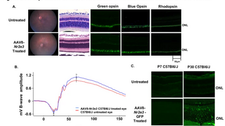PDE6B
Disease Category: autosomal recessive
Patient Population: unknown
Active Clinical Trials: None currently active
Treatment Options:
Strategies to Preserve Eye Health: Lutein
Institution(s) Conducting Research: Jules Stein Eye Institute, UPMC Scheie Eye Institute, Clinique Ophtalmologique, Quinze-Vingts (XV-XX) National Ophthalmology Hospital
FACES OF RP

Lemay-Pelletier kids
Quebec, Canada
BRIEF SUMMARY
PDE6B retinitis pigmentosa is a rare, inherited eye disease that causes vision loss. It's caused by mutations in the PDE6B gene, which encodes the beta subunit of rod cGMP phosphodiesterase, which regulates signal transduction. It is a progressive and irreversible disease. PDE6B retinitis pigmentosa is inherited in an autosomal recessive pattern. It is estimated that up to 5% of ar-RP cases are caused by mutations in PDE6B gene which encodes the beta subunit.
Symptoms include night blindness that appears early, visual field defects that worsen over time, and central vision loss. Vision loss becomes more noticeable as the disease worsens. Most patients never completely lose their vision
At this time, there is no effective treatment for PDE6B retinitis pigmentosa. Adeno-associated virus (AAV)-mediated gene therapy is a promising strategy.
This is for informational purposes only. For medical advice or diagnosis, consult a professional.


























